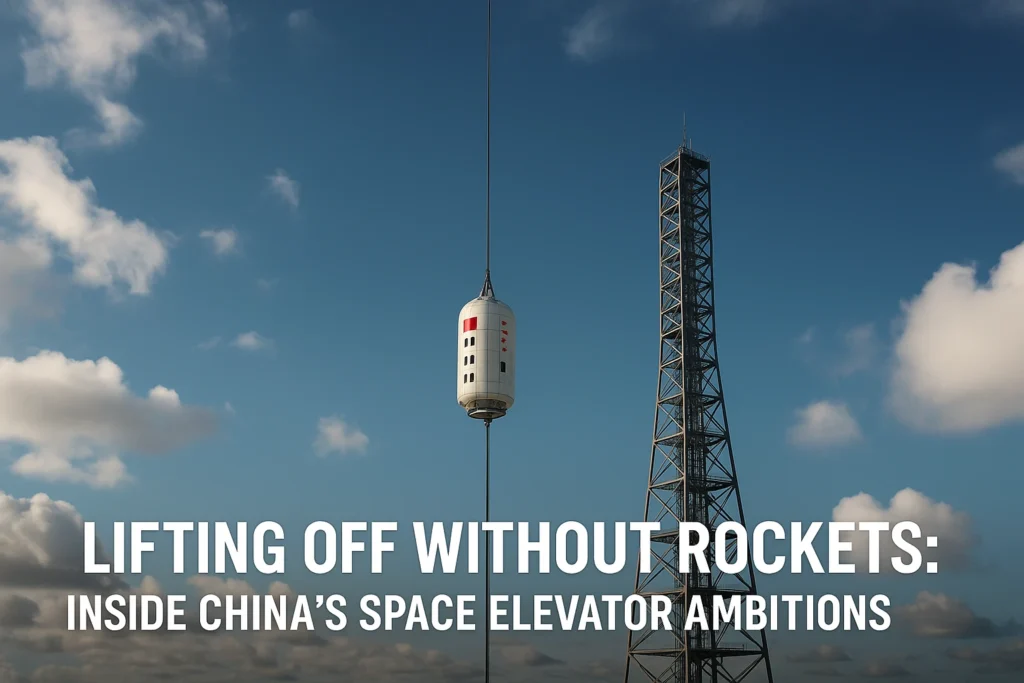Imagine stepping into a sleek capsule, not unlike a regular elevator, feeling it smoothly glide upward, not with the roaring thrust of rockets, but along an impossibly long cable stretching thousands of kilometers into the sky, past the clouds, past the atmosphere, and ultimately, into the vast emptiness of space. This isn’t just a scene from a science fiction novel. For decades, the concept of a “space elevator” has captivated engineers and dreamers, promising a revolutionary, low-cost path to orbit. Now, nations are taking this grand vision from the drawing board to the realm of serious, long-term ambition, with China emerging as a prominent player in this cosmic race.
While the monumental engineering challenge of a full-fledged space elevator remains, whispers and reports suggest that Chinese aerospace firms are actively exploring critical foundational technologies. This includes claims of successful testing of preliminary tether-based systems reaching into the stratosphere, hinting at the very first, tentative steps towards building a ladder to the stars. This isn’t just about launching satellites; it’s about fundamentally reshaping humanity’s access to space, turning it from an exclusive, violent blast-off into a routine, gentle ascent.
The Dream of the Cosmic Cable: What is a Space Elevator?
At its heart, a space elevator is a monumental structure designed to transport people and cargo directly from Earth’s surface to space, without the need for traditional rockets. Picture an incredibly strong, thin ribbon or cable anchored to the ground near the equator. This cable would stretch upward for an astonishing distance, reaching far beyond geostationary orbit (around 35,786 kilometers or 22,236 miles above Earth). At its very top, a counterweight would keep the entire system taut, balancing the downward pull of Earth’s gravity with the outward “centrifugal force” created by the cable’s rotation along with the Earth.
Vehicles, often called “climbers,” would then ascend and descend this tether, carrying payloads or even passengers. The beauty of this system lies in its potential reusability and efficiency. Once built, it could offer routine, daily access to orbit at a fraction of the cost and environmental impact of conventional rocket launches. It promises to transform space travel from an expensive, dangerous endeavor into something more akin to a long train journey or, indeed, an elevator ride.
The theoretical foundation for a space elevator dates back to 1895, when Russian scientist Konstantin Tsiolkovsky, inspired by the Eiffel Tower, first imagined a “celestial castle” connected to Earth by a giant tower. However, it was the concept of a super-strong tether that truly brought the idea into the realm of possibility, even if a distant one.
China’s Bold Horizon: A 2045 Ambition Takes Shape
In the competitive arena of space exploration, China has steadily risen to prominence, demonstrating remarkable advancements in rocket technology, lunar exploration, and ambitious plans for Mars and deep space. Amidst these impressive achievements, a particularly audacious long-term goal was quietly announced by the China Academy of Launch Vehicle Technology (CALT), a major subsidiary of the state-owned China Aerospace Science and Technology Corporation (CASC). Back in 2017, CALT outlined its vision for the future, including a startling objective: to have an operational space elevator system by 2045.
This isn’t a small side project; it’s a bold declaration of intent, signaling that China views a space elevator not as mere science fiction, but as a critical piece of future space infrastructure. For a nation that meticulously plans its technological and economic development decades in advance, such an announcement, even far into the future, carries significant weight. It implies a long-term commitment to research, development, and a gradual scaling of technologies that might one day make this colossal undertaking possible.
Why this ambition? China, like other major spacefaring nations, understands that access to space is key to future economic prosperity, national security, and scientific discovery. A space elevator could dramatically cut the cost of sending payloads to orbit, unlock the potential for large-scale space-based solar power, facilitate asteroid mining, and even pave the way for routine space tourism and human expansion into the solar system. For China, achieving such a feat would not only cement its position as a global leader in space but also provide an unparalleled strategic advantage in the new space economy.
The Stratospheric Stepping Stone: What a Prototype Might Look Like
While a full-scale space elevator reaching geostationary orbit is still firmly in the realm of theoretical physics and material science breakthroughs, the journey to such a colossal structure would begin with much smaller, yet incredibly challenging, prototypes. The mention of a “tether-based cargo lift into the stratosphere” by a Chinese aerospace firm highlights precisely this kind of foundational step.
The stratosphere, which extends up to about 50 kilometers (31 miles) above Earth’s surface, is far below the roughly 100-kilometer (62-mile) Karman Line, often considered the beginning of space. However, successfully deploying and operating a stable tether system at such altitudes would be a monumental engineering achievement in itself. It would allow engineers to test several critical technologies in a real-world environment, albeit a much less demanding one than outer space:
- Tether Deployment and Stability: How does a long, thin cable behave under tension in various atmospheric conditions? How can it be kept stable against winds and oscillations?
- Climber Mechanics: Can robotic “climbers” effectively grip and ascend/descend a tether while carrying a payload? How are they powered (e.g., via lasers beamed from the ground, or on-board energy)?
- Material Performance: While stratospheric tethers wouldn’t need the extreme strength required for a full space elevator, testing materials like advanced composites or early-stage carbon nanotubes in a relevant environment would provide invaluable data.
- Ground Station Interfacing: How would the base station anchor and manage the immense forces on the tether? How would cargo be seamlessly transferred to the climbers?
Such a stratospheric test, if confirmed and detailed, would represent a conceptual shift from pure theory to tangible engineering, providing vital insights into the challenges of deploying and controlling extremely long structures in a near-space environment. It’s akin to testing a small model airplane before designing a commercial jumbo jet – a necessary, albeit scaled-down, step towards the ultimate goal.
The Unbreakable Thread: The Quest for Ideal Materials
The single biggest hurdle to building an Earth-based space elevator isn’t orbital mechanics or power systems; it’s finding a material strong enough to support its own immense weight over tens of thousands of kilometers. Traditional materials like steel or even Kevlar would simply snap under the strain long before reaching the necessary height.
For decades, the theoretical ideal has been carbon nanotubes (CNTs). These microscopic, cylindrical structures made of carbon atoms are, pound-for-pound, arguably the strongest known material, boasting incredible tensile strength – the ability to resist being pulled apart. A ribbon made of perfect carbon nanotubes could, in theory, withstand the forces required for an Earth space elevator.
This is where much of the critical research is focused globally, and China is a significant player. Universities and research institutes in China have been at the forefront of nanomaterials science, including the development of advanced carbon nanotube fibers. Researchers at Tsinghua University in Beijing, for instance, have made headlines for synthesizing carbon nanotube fibers with unprecedented strength, some claiming a single cubic centimeter could theoretically support the weight of hundreds of elephants.
However, a huge gap remains between laboratory-scale production of incredibly strong, short CNT fibers and manufacturing kilometers-long, defect-free ribbons of consistent strength. Any tiny flaw in the material could compromise the entire structure. The challenge isn’t just making strong CNTs, but making them long and perfect. The stratospheric tether concept, even if not using full space elevator materials, would still provide crucial data on manufacturing, handling, and stress performance for extended, lightweight structures, pushing the boundaries of material science in a real-world application.
Building Blocks in the Sky: Components of the Grand Design
Beyond the revolutionary tether material, a full space elevator system requires several other sophisticated components, each presenting its own set of engineering challenges:
- The Base Station (Earth Anchor): This would be a massive, stable structure located near the equator, possibly on a floating ocean platform, to minimize environmental impact and provide flexibility for movement. It would anchor the lower end of the tether and serve as the main operational hub for cargo and passenger transfer to the climbers. Its design would need to withstand immense tension and serve as a launchpad for the climbers.
- The Climbers: These robotic or crewed vehicles would literally “climb” the tether. They would need efficient propulsion systems (perhaps powered by lasers beamed from ground stations or by energy transmitted wirelessly along the tether) and mechanisms to securely grip and ascend the ribbon without damaging it. Their design would also need to account for varying gravitational forces and the transition from atmospheric flight to the vacuum of space.
- The Counterweight (Space Anchor): Located far beyond geostationary orbit, this massive object would provide the necessary outward force to keep the tether taut. It could be a captured asteroid, a decommissioned space station, or even a specially constructed facility. This “apex anchor” would also serve as a crucial staging point for future missions to the Moon, Mars, or beyond, giving payloads an initial velocity that dramatically reduces the need for propulsive burns.
- Power Beaming System: Transmitting massive amounts of power to the climbers over tens of thousands of kilometers is a significant challenge. Laser power beaming from ground stations or orbital mirrors is one proposed solution, requiring highly precise aiming and adaptive optics to compensate for atmospheric distortion.
- Space Debris Mitigation: The long tether would inevitably pass through regions of Earth orbit populated by space junk. The system would need robust defenses, including active avoidance maneuvers, a tapered or ribbon-like design to minimize impact probability, and potentially even active debris removal systems.
Each of these components represents a frontier of engineering, and progress on any one of them pushes the entire concept closer to reality.
The Economic Pull: Why Bother with a Space Elevator?
The sheer scale and complexity of a space elevator beg the question: why pursue such a colossal undertaking? The answer lies in its transformative potential, primarily in drastically reducing the cost and increasing the frequency of access to space.
- Massive Cost Reduction: Current rocket launches are incredibly expensive, primarily due to the single-use nature of most rockets and the immense amount of fuel required to escape Earth’s gravity. A space elevator, once operational, could potentially lower the cost of putting a kilogram of payload into orbit from tens of thousands of dollars to perhaps just a few hundred dollars. This would unlock entirely new industries and applications in space.
- Routine and Reliable Access: Rockets are subject to weather delays and complex launch preparations. An elevator, designed for continuous operation, could offer daily, predictable access to orbit, making space travel far more routine and accessible for a wider range of users, from scientific researchers to commercial entities.
- New Space Industries: Cheaper and easier access to space could make ventures like large-scale space-based solar power (beaming energy back to Earth), asteroid mining for valuable resources, and the construction of massive orbital habitats economically viable. Imagine factories built in zero-gravity or vast power plants orbiting Earth, all fueled by the ease of the elevator.
- Environmental Benefits: Rockets release significant amounts of greenhouse gases and other pollutants into the atmosphere. An electrically powered space elevator would offer a far greener alternative, drastically reducing the environmental impact of accessing space.
- Gateway to the Solar System: The counterweight at the top of the elevator would not only hold the tether taut but also serve as a launch platform. Objects released from this point would already have significant velocity, requiring far less energy to travel to the Moon, Mars, or even beyond, effectively acting as a slingshot into the solar system.
These profound advantages make the space elevator a “holy grail” of space infrastructure, promising to expand humanity’s reach and capabilities in ways previously unimaginable.
The Global Race: Who Else is Reaching for the Stars?
While China’s 2045 ambition is noteworthy, the concept of a space elevator has been a subject of international research and discussion for decades. It’s not a race with a single front-runner, but rather a global collaborative effort, albeit with various national interests and research priorities.
- Japan (JAXA and Obayashi Corporation): Japanese researchers, particularly from Obayashi Corporation, have also famously articulated plans to build a space elevator by 2050. Their proposals include utilizing robotic climbers and advanced carbon nanotube technology. Japan has also conducted small-scale experiments, such as deploying a miniature elevator model between two CubeSats in low Earth orbit, demonstrating basic tether and climber mechanisms in space.
- United States (NASA, NIAC, Academic Research): NASA’s Institute for Advanced Concepts (NIAC) has funded various preliminary studies on space elevator components and materials. Numerous academic institutions and private companies continue to research high-strength materials (like various forms of carbon and advanced polymers) and propose different architectural approaches, including “orbital rings” or lunar space elevators.
- International Space Elevator Consortium (ISEC): This global non-profit organization brings together scientists, engineers, and enthusiasts to promote space elevator development. They hold annual conferences, publish research, and work to advance the technological readiness of the concept, fostering international collaboration on this grand engineering challenge.
The global competition in space is often framed by rocket launches and lunar landings, but the space elevator represents a deeper, more fundamental competition: who can truly revolutionize our long-term access to space? Each nation’s contribution to material science, robotics, and large-scale engineering brings the collective dream a step closer to reality.
Navigating the Challenges: From Debris to Regulation
Despite the tantalizing benefits, the path to building a functional space elevator is fraught with immense, multifaceted challenges that extend far beyond just finding a super-strong material.
- Space Debris: Earth’s orbits, especially Low Earth Orbit (LEO) and Geostationary Earth Orbit (GEO), are increasingly crowded with defunct satellites and rocket fragments – “space junk.” A space elevator tether, stretching through these altitudes, would be a massive target. Even a small impact from a high-velocity piece of debris could cause catastrophic damage. Active debris removal, advanced collision avoidance systems, and robust material design would be paramount.
- Orbital Mechanics and Stability: Maintaining the stability of a structure tens of thousands of kilometers long, subject to gravitational shifts, solar winds, and even lunar tides, is incredibly complex. The base station and counterweight would need sophisticated systems to actively manage the tether’s tension and position.
- Energy Transfer: Powering climbers ascending thousands of kilometers is a huge energy challenge. While laser beaming is proposed, ensuring efficient and safe energy transfer over such vast distances remains a hurdle.
- Construction Logistics: How do you even begin building something this immense? Initial concepts involve launching a smaller “seed” tether and then gradually thickening and extending it, potentially using materials manufactured in space. This would be the largest construction project in human history.
- Environmental Impact: While operationally cleaner, the construction phase could have environmental impacts. Furthermore, a permanent structure extending into space could potentially influence Earth’s magnetosphere or atmosphere in unforeseen ways, requiring extensive environmental assessments.
- Regulatory and Legal Frameworks: Who owns the space elevator? How is its airspace managed? What are the international legal implications of a permanent structure connecting Earth to space? Establishing global agreements and regulatory bodies would be crucial.
- Extreme Environments: The tether and climbers would need to withstand harsh conditions: vacuum, extreme temperature swings, radiation, and micrometeoroid impacts.
Overcoming these hurdles will require unprecedented levels of international collaboration, scientific breakthroughs, and sustained financial commitment.
Conclusion: Redefining Humanity’s Ascent into Space
The idea of a space elevator, once confined to the pages of science fiction, is slowly but surely moving towards the realm of engineered possibility. China’s stated ambition for a space elevator by 2045, coupled with its intensive research into advanced materials and its broader strategic vision for space, positions it as a key player in this audacious endeavor. While reports of specific stratospheric tether tests remain to be fully detailed and confirmed, they hint at the practical, step-by-step approach necessary to tackle such a gargantuan project.
The journey to a fully operational space elevator will undoubtedly be long and fraught with challenges, pushing the boundaries of material science, robotics, and international cooperation. Yet, the potential rewards are immense: routine, affordable, and environmentally friendly access to space, unlocking a new era of exploration, resource utilization, and human expansion beyond our home planet. As nations continue their quiet, determined efforts, the dream of a ladder to the stars remains a powerful symbol of humanity’s enduring quest to reach beyond its terrestrial bounds and redefine its place in the cosmos.



